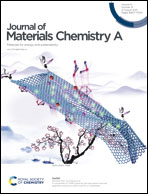An efficiency of 14.29% and 13.08% for 1 cm2 and 4 cm2 flexible organic solar cells enabled by sol–gel ZnO and ZnO nanoparticle bilayer electron transporting layers†
Abstract
Flexible organic solar cells (OSCs) will be a promising energy harvest approach for portable and wearable electronics. However, the efficiency of flexible OSCs, particularly the efficiency of flexible devices with an area larger than 1 cm2, is still limited due to the lack of good flexible electrodes and the inhomogeneity of the large-area films. In this work, higher sensitivity of the performance to the interface contact for large-area devices (1 and 4 cm2) than small area devices (0.09 cm2) was found in flexible OSCs with different areas. To address this issue, a bilayer electron transporting layer (ETL) combining a lower sol–gel ZnO and an upper ZnO nanoparticle layer was developed for silver nanowire (AgNW) electrode involving large-area flexible OSCs. The use of the lower sol–gel ZnO layer effectively filled the network voids and modified the surface energy of the AgNWs, which enabled the homogeneous coverage of the upper ZnO nanoparticle layer and enhanced carrier collection. Due to the more homogeneous films and improved interface charge collection, the use of the sol–gel ZnO and ZnO NP bilayer ETL has lowered the performance decrease during upscaling. A record efficiency of 14.29% and 13.08% for the 1 and 4 cm2 flexible OSCs was achieved.



 Please wait while we load your content...
Please wait while we load your content...